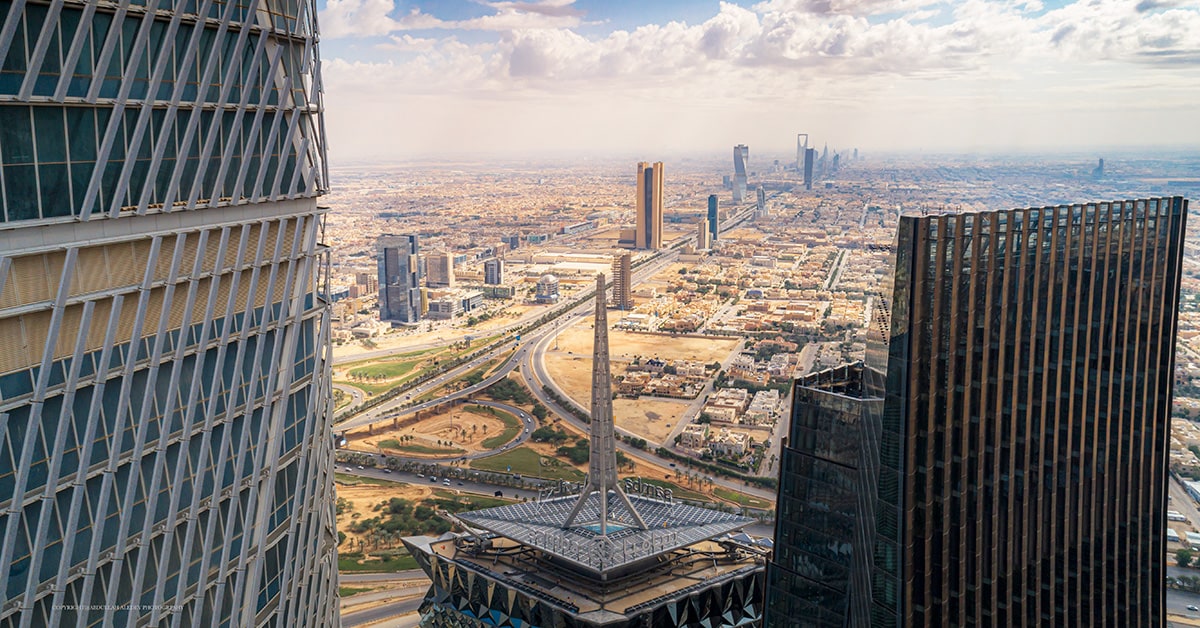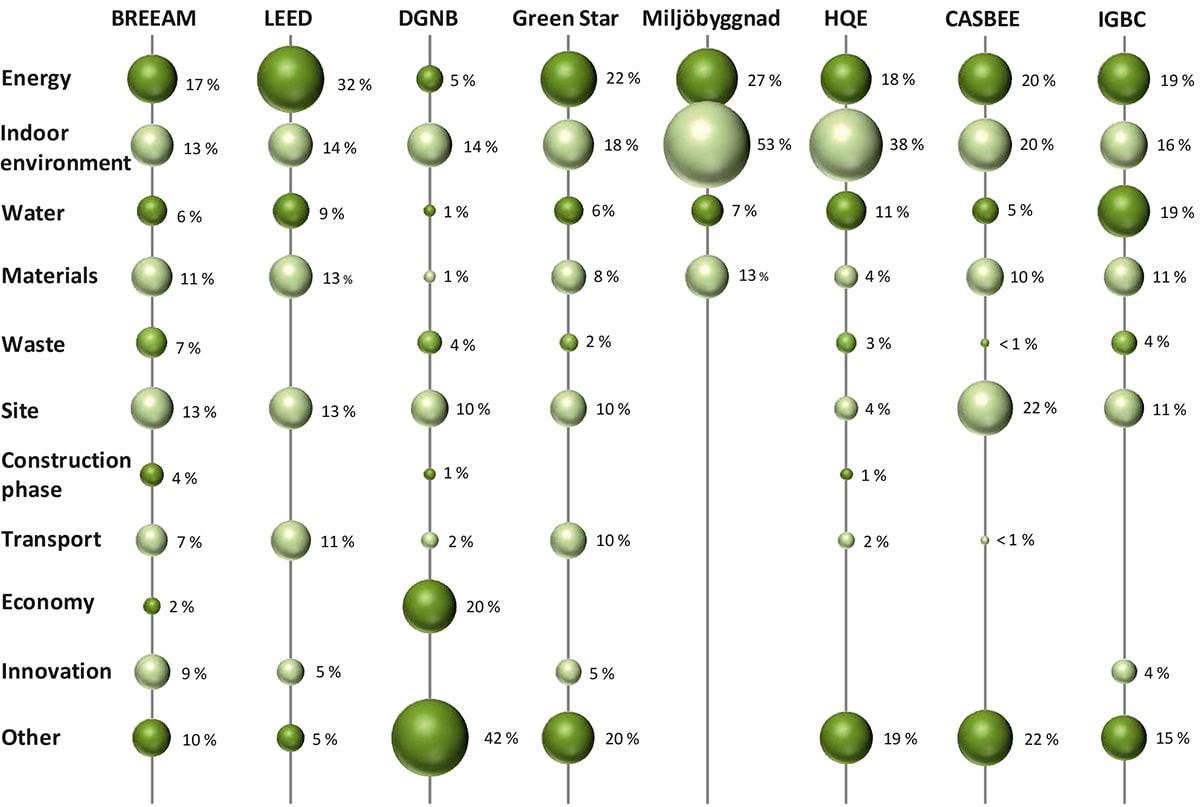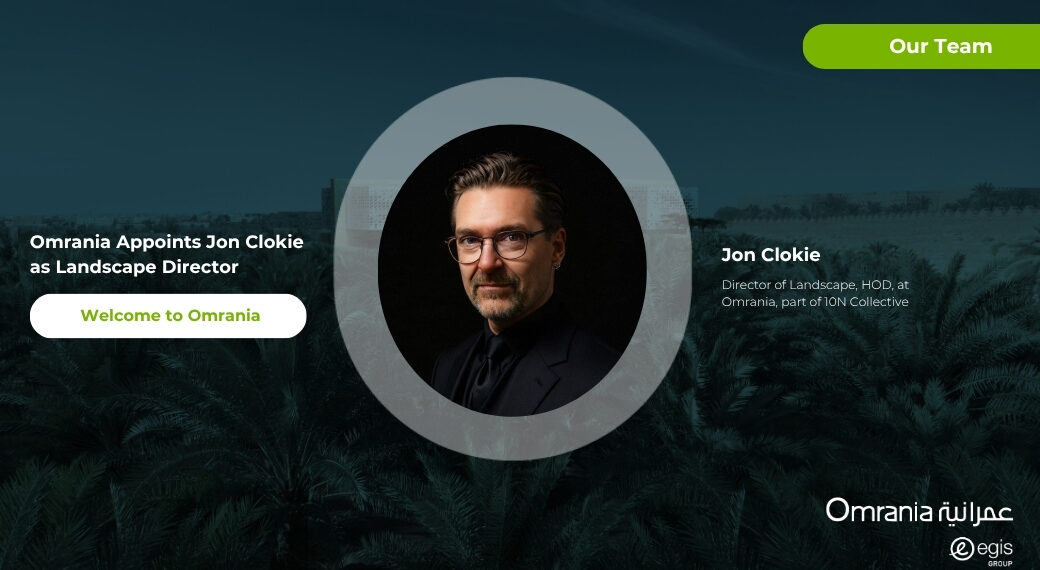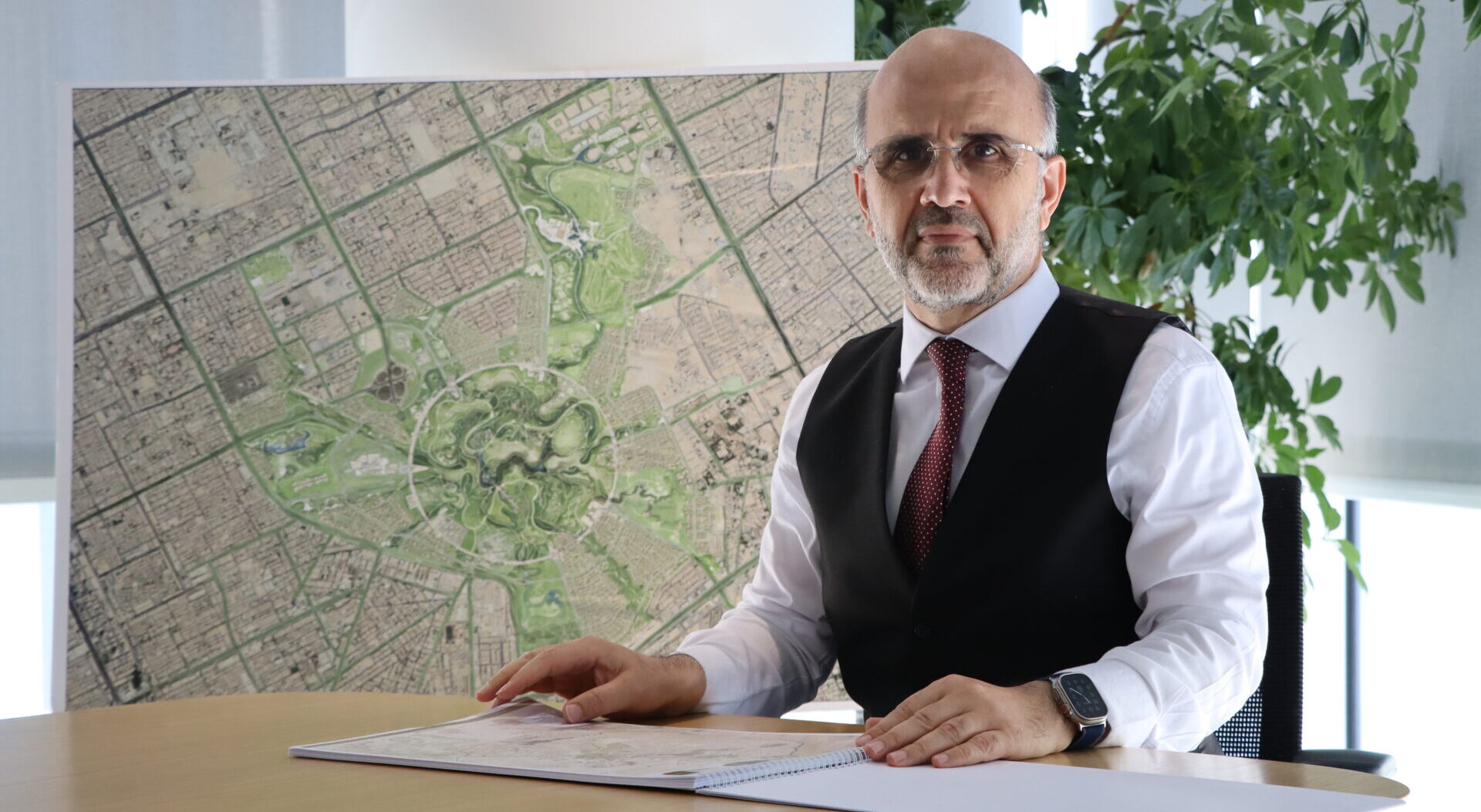 The PIF Tower overlooking the KAFD and the city of Riyadh. Photo © Abdullah Aledey
The PIF Tower overlooking the KAFD and the city of Riyadh. Photo © Abdullah Aledey .
In the second of our four-part series, we explore the critical issues as they contribute to Sustainable design in the Middle East, and specifically within Saudi Arabia. In particular, we examine notions of the cultural appropriateness of the meaning of Sustainability.
By: Marcus Leyland – Chief Architect
In the first preceding part of this exploration of Sustainable design in Saudi Arabia, we discussed the way in which the approach to design that Sustainability requires has evolved away from that in Western Countries, with differing priorities and issues defining the two separate paths. What might be called ‘Political’ Sustainability, and that which is largely recognized in the West as mainstream Sustainability, is informed by Western political and self-styled ‘internationalist’ themes and ideas that are not, to varying degrees, part of many Middle Eastern traditions. For example, policies of social change that are part of traditional or present culture in Western countries, cannot simplistically be imposed on those countries of the Middle East where that are not part of that culture. It is agreed amongst wise council across the globe that this form of Liberal Imperialism belongs in the past.
Therefore, we suggest the notion of Pragmatic Sustainability as reflecting the array of challenges and responses needed to address balance in the way we design cities and buildings in Saudi Arabia and the broader Middle East region in the 21st Century.
Founded on a need to support drives towards a long-term, sustainable economy, Pragmatic Sustainability addresses matters of resource depletion and scarcity, occupant comfort and productivity, and most significantly, the cultural aspect of Sustainability that many generic models fail to do: So much in Sustainable design relies upon ideological assumptions and norms that do not easily translate between cultures. Underlying all policies of this pragmatic approach is the contribution they make to sustaining a stronger, leaner, more productive, and more competitive economy. Without a sound financial basis for any economy, policies on Sustainability or any other subject for that matter are meaningless and merely esoteric at best.
Conservation and Energy
Resource scarcity and depletion require two main issues to be addressed, namely resource conservation in manufacturing and construction, and energy consumption necessary to manufacture and transport materials. In most European and North American countries, this is perceived as a series of issues driven by a desire to reduce carbon emissions. While carbon-emissions reduction remains a concern, for Middle Eastern Counties with fast expanding populations and depleting oil-based revenues; Sustainability is a matter of lowering the cost inefficiency to governments who for the most part fund major construction projects. By reducing the amount of materials and products that are commonly imported vast distances, there are multiple benefits to encouraging local manufacture of products using local labor. Both measures ultimately reinforce and bring greater self-sufficiency and long-term resilience to the economies of the region’s countries.
In many countries, most focus on energy efficiency is in the cost in use by base buildings. This is often erroneously considered the only energy efficiency target that needs to be addressed. This includes the electrical energy required for cooling, ventilation, lighting, and the often-overlooked matter of live power loads within buildings. In many cases, base building efficiency can be more than negated by inefficient or non-existent policies on ICT procurement and live loads and resulting additional cooling within the building.
It is estimated that for a well-designed, efficient, typical medium sized, three storey office building that ‘plug’, or ‘small power’ cooling loads may be as high as 50% of the total energy use cost. In recent studies from California, this figure has been shown to be as high as 66% in hot and arid climates. With base building loads dropping rapidly because of targets set through initiatives such as Estidama, LEED, and BREEAM, the next challenge we face will be to match those efficiencies through similar schemes for the equipment and data systems used within those high-efficiency office interiors.
Embodied Energy
The second aspect of energy reduction concerns the often less often considered issue of embodied energy. This is the initial embodied energy it takes to extract, produce and transport the product to its final place of construction, plus the recurring embodied energy used in the maintenance and repair of a building, including its eventual dismantling or demolition. Such energy comprises between 20 and 40% of the total energy used by that building throughout its service life.
Often, it can be difficult to measure such energy costs unless legislation or a green building program through which a project is being carried out required such data. Its understanding requires sophisticated computer energy use and life-cycle cost analysis modeling available readily in Europe and North America but currently only from a few larger design consultancies within the Middle East Region.
Whilst only contributing a smaller percentage of the life cycle energy cost of a building, if materials are manufactured using oil derived energy and water, then its cost to the broader economy can be significant. One alternative may be to pay the additional costs of importing that product from outside of the region; this presents issues concerning the indirect cost of outsourced labor and knowledge from the Region, and a contribution to an already significant loss of economic autonomy for the Countries of the Middle East. The choice of materials using in construction, therefore, should consider embodied energy as a broader economic issue as part of the process of economically sustainable design.
Resource Use Efficiency
This third aspect if energy efficiency is driven by the building fabric itself, so often overlooked during project programming, budgeting, and design. The durability of a building is a factor of how long that building is intended to last or its ‘economic service life’ (ESL), and the projected cost to operate and maintain (O&M) the building over that period. More durable buildings are designed to last a long time and at minimal O&M cost. For LEED ’Gold’ projects an ESL of 100+ years is commonplace. Where project budgets are exclusively based on upfront capital cost, it is easy to ignore this wider issue of building durability, and yet for a long-term institutional owner, the initial development cost of a building may only account for 6-8% of its total ESL cost. Durability is important as the energy and water resources invested in that building will be wasted in the case of low durability buildings. Again, if oil is the primary source of energy and water used in construction, then its cost to the wider economy can be significant.
In simple terms, solutions that offer higher energy efficiency and building durability may be fundamentally passive, such as reflective or shielded roof systems, appropriate use of building mass, and correct orientation of building form. Active system includes the need to follow optimized energy performance design and commissioning standards, and then to upkeep those best practices during the O&M phase of the buildings life. This should include the measurement and verification of energy performance so that initial design assumptions may be tested, and system or equipment settings modified to optimize energy use.
More fundamental an issue for Saudi Arabia and the wider region is the issue of water scarcity and efficiency in use. We will not discuss this issue in this article as it forms the central theme of the article that follows.
Economic Common Sense
Whilst energy and water as resources are essential, the key resource for any country is the people who make up the labor and intelligence base of its workforce, and the economic benefit they bring to the country. The construction industry is the Kingdoms second largest contributor to GDP after oil, with the figure at 10% in 2013. Whilst these revenues, generated mainly through the design and contracting portion of the sector seem substantial, there are missed opportunities to boost contributions to GDP by manufacturing more of the construction materials used within the country, reducing the Kingdoms reliance on imports from often far away sources. Such a transformation would also benefit carbon reduction targets in limiting the cost and emissions associated with transportation.
Many of the materials and systems such as renewable energy systems and materials used in high-performance building envelopes are new and innovative with comparatively prices often reflecting this. Some, for example, aluminum shading louvers, glazed façade systems, and HVAC systems are obtainable from far eastern countries such as China, but often carry worrying quality issues. The market opportunity for manufacturing to be carried out locally exists and needs to be exploited to make high-performance buildings more affordable. Once established, the export potential to other middle eastern countries, with weaker economies than Saudi Arabia, and who also currently suffer a need to import from long distances would exist.
Both LEED and BREEAM assessment systems reward projects for adopting or supporting renewable energy systems either through the on-site placement of generation systems or by committing to making payments to more generally available programs that promote or fund renewable energy programs by ‘green’ energy providers. These credits have always been controversial amongst the green building community for several reasons. The addition of a few solar panels or wind turbines to a site may make a visual statement about the owner’s commitment to green energy, but typically generate a tiny percentage of the power used by a building.

The benefits of such measures in terms of carbon reduction are sometimes significantly outweighed by poor envelope, lighting or HVAC systems design because of underinvestment in those vital building systems. The money invested in the renewable systems would have been better spent on improved façade, lighting and HVAC systems in terms of the energy performance and carbon footprint of the building.
Contributions to green energy funding are also often seen as ‘buying credits’ where proper investment in designing a genuinely high-performance building would have benefited energy reductions, rather than merely buying energy that would otherwise not have been required. It remains a matter of conjecture therefore whether renewable energy systems credits should remain part of green building certification systems.
BREEAM does address what it calls ‘social’ aspects of sustainability through several credits amongst its many green building certification models. Whilst many are not culturally relevant, one remains economically relevant that calls for the training of the local skilled workforce through the contractor and sub-contractors as a means of skills transfer to local markets. This carries both cultural and economic benefits and could apply to both the design and the contracting teams in being recognized through certification.
Occupant Performance
The measurement, verification, and control of indoor air quality is a recent innovation within the region and follows from the development and import of the sensor and monitoring systems from the US and Europe. Poor air quality can have a remarkable effect on workplace productivity with recent filed validation studies carried out in the US indicating as much as a 9% drop in office worker performance. The wider impact on an organization’s or business’s performance may be substantial when considering the cost of salaries as a proportion of owning and operating a building throughout its ESL, and as part of life-cycle cost analysis, might be in the order of 80-85%. This equates this loss of employee performance to approximately equal to or more than the initial construction cost of a typical office building!
Measures to improve air quality include the employment of building management, passive and active design strategies. The starting point for air quality control is to eliminate toxins and allergens through proper filtration of incoming air, and considered selection of materials used within the building envelope, and in the cleaning of the building. HVAC and cooling systems should be designed to current and best practice standards determined by systems such as ASHRAE Monitoring of air quality employing a sensor network throughout occupied areas will detect toxins, low oxygen levels, and high CO2 levels before occupant are aware and adjust pre-conditioned outdoor air supply rates accordingly. Toxin alerts will bring to the attention of building managers the presence of VOC’s or other gaseous or particulate substances that might impair health. Policy direction including the avoidance of tobacco and scents that may cause health issues or allergic reactions should be publicized amongst staff, and the policy enforced.
Green building systems such as LEED and BREEAM reward improvements in daylighting optimization within interior areas, and when views to the exterior and the sky are facilitated in the design. These notions have their origin mainly in northern European and North American counties. In Germany for example, building plan depth is legislated for this reason. In the Middle Eastern Region, a different problem exists where there can be an excess of light to the point that it presents a glare problem. Current green building systems do not address this fundamentally different issue well. The only option is to pursue an innovation credit addressing glare control and daylight control and distribution using very different design and technology solutions than those envisaged through LEED.
Securing The Future
The final issue we wish to discuss has become increasingly prevalent amongst green building designers in recent years. Many in the industry have recognized a fundamental weakness within the green building certification process in the way that once buildings are completed and handed over, that there is little or no continued verification of their performance. We discuss this issue in more detail in the following article ‘the promise of green’.
The introduction by the USGBC of delays in certification, pending publication of energy performance figures for the first two years following occupancy is a step in the right direction. The need for real follow-through after occupancy, however, will likely be addressed by the potential idea of cyclical verification process whereby certification is only for a limited period, requiring recertification every few years. In practical terms, this means the high-performance status of a building will depend upon the owner or landlord operating and maintaining the building to its fullest potential. In turn, tenants would also carry obligations included in their contracts of tenancy. Failure to do so could mean a loss of certification and if energy use commitments have been made between parties, be they landlords, tenants or investing agencies, possible contractual ramifications.
Conclusions
Pragmatism in sustainable design means simplifying our understanding of what lies at the core of our aims and objectives, focusing on what is essential, ignoring that which is esoteric or less certain in its benefits. By focusing on doing more with less, on what contributes to the productivity the key assets for both companies and the government; namely the workforce, on the real economic value and cost in what we invest, and in ensuring that these benefits continue to be delivered in the future, we have a simple formula for sustainable design.
Cultural or political ‘nice to haves’ may be added to the formula at its periphery but unless they can be proven to benefit the real-world economic needs of an owner or developer, they should not become prerequisite or even necessary in defining what is sustainable. What is most important is that these additional sub-definitions of sustainability are formulated locally and without external expectation or influence.







